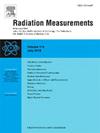A novel deep learning-based artificial intelligence method for automated apatite fission-track identification
IF 2.2
3区 物理与天体物理
Q2 NUCLEAR SCIENCE & TECHNOLOGY
引用次数: 0
Abstract
Fission-track dating is a widely used thermochronological technique. The traditional manual identification of fission tracks under a microscope is time-consuming and susceptible to counting errors. A novel deep learning-based method was proposed to detect fission tracks automatically. Our method consists of the following steps. 1) Utilizing the Mask Region-based Convolutional Neural Network algorithm to locate fission tracks and extract their boundary coordinates. 2) Using ellipses to fit the fission tracks’ boundary coordinates. 3) Analyzing the fitted ellipse parameters to handle overlapping tracks. 55 spontaneous fission-track images were utilized for training and 15 images for testing. The algorithm provided excellent detection performance for most samples, with few omission and commission errors. These results indicate that the method has significant potential for automated fission-track identification and distinguishes between overlapping and single tracks.
一种基于深度学习的人工智能磷灰石裂变径迹自动识别方法
裂变径迹测年是一种广泛使用的热年代学技术。传统的人工鉴定在显微镜下的裂变径迹既费时又容易计数错误。提出了一种基于深度学习的裂变轨迹自动检测方法。我们的方法包括以下步骤。1)利用基于Mask区域的卷积神经网络算法定位裂变轨迹并提取其边界坐标。2)利用椭圆拟合裂变轨迹的边界坐标。3)分析拟合的椭圆参数,处理重叠轨迹。55张自发裂变轨迹图像用于训练,15张用于测试。该算法对大多数样本都具有良好的检测性能,几乎没有遗漏和调试误差。这些结果表明,该方法在裂变径迹自动识别和区分重叠径迹和单径迹方面具有很大的潜力。
本文章由计算机程序翻译,如有差异,请以英文原文为准。
求助全文
约1分钟内获得全文
求助全文
来源期刊

Radiation Measurements
工程技术-核科学技术
CiteScore
4.10
自引率
20.00%
发文量
116
审稿时长
48 days
期刊介绍:
The journal seeks to publish papers that present advances in the following areas: spontaneous and stimulated luminescence (including scintillating materials, thermoluminescence, and optically stimulated luminescence); electron spin resonance of natural and synthetic materials; the physics, design and performance of radiation measurements (including computational modelling such as electronic transport simulations); the novel basic aspects of radiation measurement in medical physics. Studies of energy-transfer phenomena, track physics and microdosimetry are also of interest to the journal.
Applications relevant to the journal, particularly where they present novel detection techniques, novel analytical approaches or novel materials, include: personal dosimetry (including dosimetric quantities, active/electronic and passive monitoring techniques for photon, neutron and charged-particle exposures); environmental dosimetry (including methodological advances and predictive models related to radon, but generally excluding local survey results of radon where the main aim is to establish the radiation risk to populations); cosmic and high-energy radiation measurements (including dosimetry, space radiation effects, and single event upsets); dosimetry-based archaeological and Quaternary dating; dosimetry-based approaches to thermochronometry; accident and retrospective dosimetry (including activation detectors), and dosimetry and measurements related to medical applications.
 求助内容:
求助内容: 应助结果提醒方式:
应助结果提醒方式:


